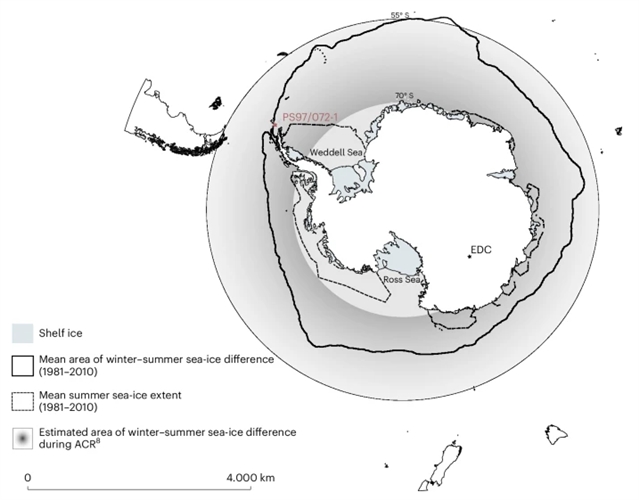
近日,德国阿尔弗雷德·韦格纳研究所亥姆霍兹极地和海洋研究中心Kathleen R. Stoof-Leichsenring团队实现了从沉积的古代DNA来分析南极寒流逆转期间藻华的碳吸收。相关论文于2025年8月25日发表在《自然—地球科学》杂志上。
南大洋在全球碳预算中扮演着至关重要的角色。了解这一作用的一个关键间隔是南极寒潮(14,700-12,700校准年 bp),这是南半球特有的降温事件,暂时逆转了变暖和大气二氧化碳上升的冰川消融趋势。模拟研究表明,南极冷逆转期间的大气二氧化碳高原与海洋生产力的增加有关。然而,对初级生产者群落的代理约束仅限于留下化石记录的群体子集。
研究组将古代DNA散弹枪法元基因组学应用于海洋沉积物岩心样本,以表征海洋生态系统在所有营养水平上的组成,发现在事件期间,南极褐藻是主要的主要制造者。来自同一记录的独立代理证据表明,由于变冷导致海冰季节性增强,生产力提高。南极寒流逆转后,褐囊藻群落的突然消失表明了这个生态系统对变暖的敏感程度,这可能是一个关键的临界点。作为当前变暖的一个类似,它强调了具有高季节性海冰变率和棕囊藻优势的地区(如罗斯海)在稳定大气CO2含量方面的重要性。
附:英文原文
Title: Carbon drawdown by algal blooms during Antarctic Cold Reversal from sedimentary ancient DNA
Author: Wei, Josefine Friederike, Herzschuh, Ulrike, Mller, Juliane, Liang, Jie, Vorrath, Maria-Elena, Perfumo, Amedea, Stoof-Leichsenring, Kathleen R.
Issue&Volume: 2025-08-25
Abstract: The Southern Ocean plays a crucial role in the global carbon budget. One key interval for understanding this role is the Antarctic Cold Reversal (14,700–12,700 calibrated (cal) yr bp)—a Southern Hemisphere-specific cooling event that temporarily reversed the deglacial trend of warming and rising atmospheric CO2. Modelling studies propose that the atmospheric CO2 plateau during the Antarctic Cold Reversal is related to increased marine productivity. However, proxy constraints on the primary producer community are limited to the subset of groups that leave a fossil record. Here we applied ancient DNA shotgun metagenomics to samples from a marine sediment core to characterize the composition of the marine ecosystem across all trophic levels, finding that the haptophyte algae Phaeocystis antarctica was the dominant primary producer during the event. Independent proxy evidence from the same record points to high productivity in response to enhanced sea-ice seasonality caused by the cooling. Post Antarctic Cold Reversal, abrupt Phaeocystis community loss shows how sensitive this ecosystem is to warming, potentially representing a key tipping element. As an analogy for present warming, it highlights the importance of regions with high seasonal sea-ice variability and Phaeocystis dominance, such as the Ross Sea, in stabilizing atmospheric CO2 content.
DOI: 10.1038/s41561-025-01761-w
Source: https://www.nature.com/articles/s41561-025-01761-w
